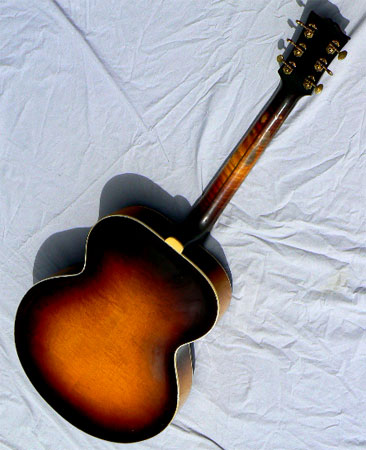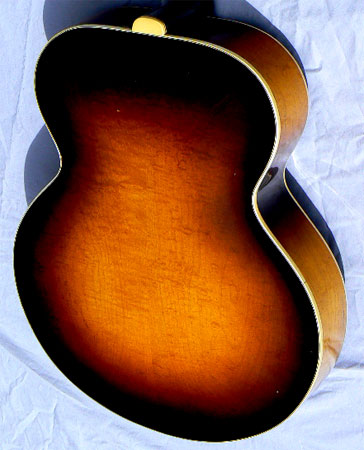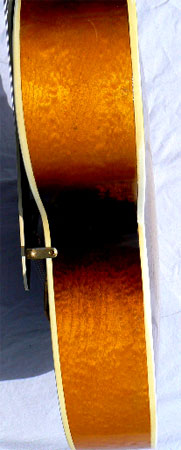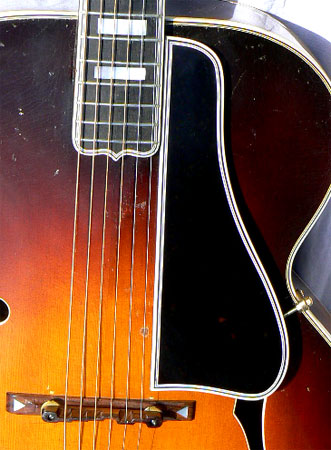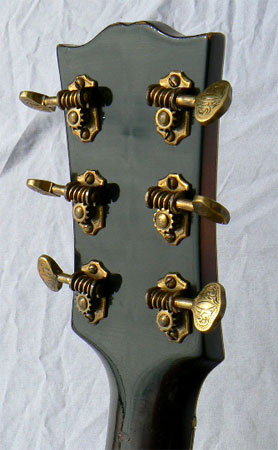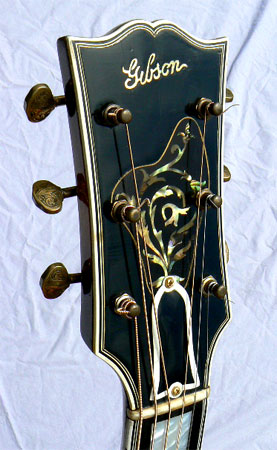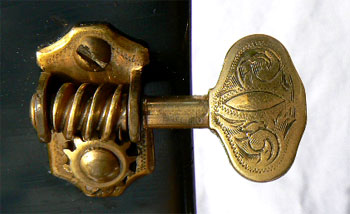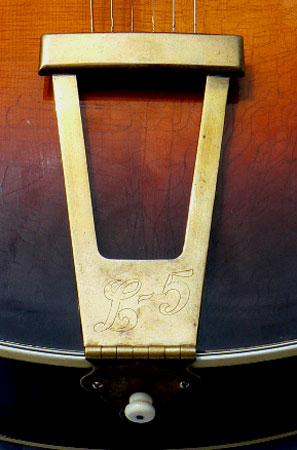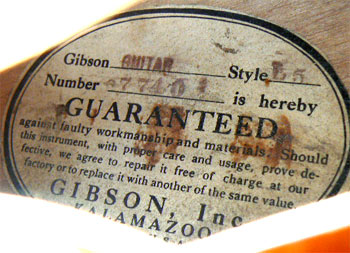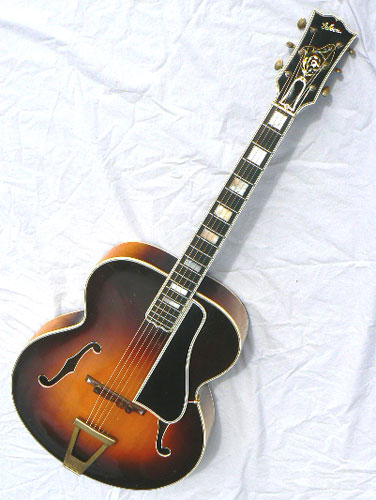
Home / Instruments /Accessories / Ordering / Tips / Friends
archtop.com
1943 Gibson L-5 "Fern"
Price and Status: For pricing and hold status of this instrument, please check here. If this instrument does not appear on the Instruments page it has been sold. To be notified of examples of this or any other model in the future, please email your specific requests to [email protected].
Serial #: 97740, white oval label
Body size at lower bout: 17", Scale length: 25 1/2" Nut Width: 1 11/16"
Finish: Cremona sunburst finish, nitrocellulose lacquer type.
Materials: Figured solid handcarved bubble flame maple back and sides; handcarved bookmatched solid spruce top; solid tiger flame maple neck; solid ebony fingerboard with block mother of pearl fingerboard inlays; unique ornate floral headstock inlay with small script pearl Gibson peghead logo; quintuple bound body, fingerboard and headstock.
Hardware: Original hardware includes prewar L-5 logo trapeze tailpiece; compensated adjustable Brazilian rosewood bridge with pearl inlaid feet; engraved gold Grover butterbean tuners; adjustable truss rod. Vintage correct quintuple bound dark tortoise pickguard.
Notes: Since the very first Gibson L-5 rolled off the production line in 1923, the model has gone through changes large and small, in dimensions, ornamentation and overall design. In the better part of a century of production, however, one signature feature has remained constant: the graceful torch (or flowerpot) inlay on the peghead. Until now.
1943 was the absolute depth of the Second World War, and Gibson instrument production slowed to a trickle, as the firm devoted itself to the production of strategic materiel. We are told that only a skeleton crew was assigned to finish up back orders, making guitars from the war years the rarest of the 20th century. So scarce are guitars from this model year in particular that this example is the only example of an L-5 from 1943 we can find in our files.
Materials were tightly rationed, so Gibson made creative use of its vast parts stock, making wartime instruments the most unusual in design as well. The tailpiece on this guitar is of the type used on the earliest 17" 'Advanced Model' L-5s, and seen only in 1935 and '36. Engraved with the L-5 logo, this short-lived trapeze is the rarest tailpiece variant in the model's history. Parts otherwise seen only on the prewar Super 400 are also fitted to this instrument, including the Brazilian rosewood bridge with pearl inlaid wedges, and most notably the extravagantly hand-engraved gold Grover butterbean tuners, the most costly and ornate tuning machines of their time, and also seen on some prewar 45 style Martins.
And finally, the peghead. In place of the traditional torch inlay, this instrument is graced with a complex floral pattern unlike that seen on any standard Gibson. The border around the inlay is reminiscent of the "picture-frame" inlays found on the prewar L-7, which were pulled from unused banjo fingerboards. However, this inlay pattern is far too big for a banjo, and the only place it might fit on a mandolin might be on one of the inlaid pickguards of the Orville Gibson era. As unusual as it is, we do know that this ornamentation is indeed original Gibson work, as we have seen this pattern on at least two other instruments, both custom artist models.
The earliest is an L-5 built in 1934 to the specifications of jazz pioneer and Gibson endorser Carl Kress, and pictured here. The other was made for the celebrated plectrist Roy Smeck, another Gibson artist, and built right around the time the present guitar was constructed, in the middle of the Second World War. Perhaps the pearlwork was ordered pre-inlaid from one of the European suppliers, and held in stock specifically for artist or custom models. Whatever the reason, this intriguing pattern is one of the rarest to be seen on any Gibson guitar, and these few examples are the only L-5's made in the model's history without Lloyd Loar's classic torch in the peghead.
This remarkable guitar was part of the legendary collection of Akira Tsumura, the most prolific and discriminating collector of the 20th century, and has been preserved in exceptionally fine condition, complete with its original Gibson 'red stripe' hardshell case. The instrument shows no cracks or buckle wear, and only some light bits of thumb and knee wear, and a few scattered lacquer dings in the original deep sunburst finish. The neck profile is a gentle C, full but not clubby, with comfortable low action over a fine set of older medium frets. At just 5lb, 13oz, the guitar is substantially lighter that the typical 17" L-5, and has a wonderfully rich, open voice, with excellent clarity and projection, ideal for comping or chord melody alike. A magnificent instrument from Gibson's scarcest era ever, the L-5 'fern' is one of the most highly distinctive instruments in the company's history.
Setup: The frets have been precision leveled, recrowned and polished as required; trussrod tension and neck relief adjusted; bridge height adjusted; bridge compensation set; string slots at nut and bridge inspected and recut as necessary; bridge foot contour inspected and fit to top as necessary; bridge radius inspected and recurved as necessary; bridge wheels and tuners lubricated; fingerboard and bridge oiled; body and neck cleaned and hand polished.
This instrument is strung with medium gauge bronze strings (.013-.057). The guitar will accommodate lighter or heavier gauge strings, according to preference. String action is set at 5/64" to 6/64" at the 12th fret, with moderate relief for acoustic playing with medium strings. The action may be lowered or raised to your requirements with the adjustable bridge.
Case: Original black Gibson 'red stripe' hardshell case.
